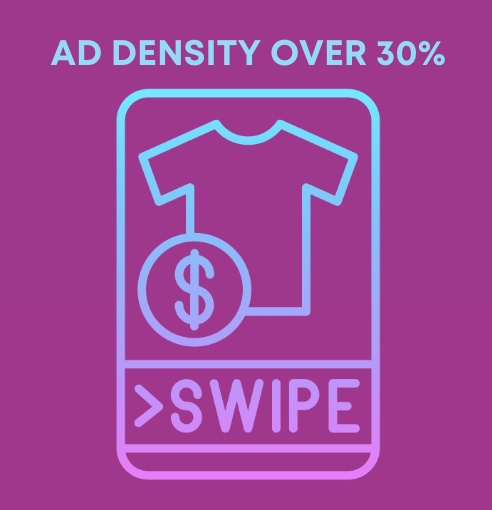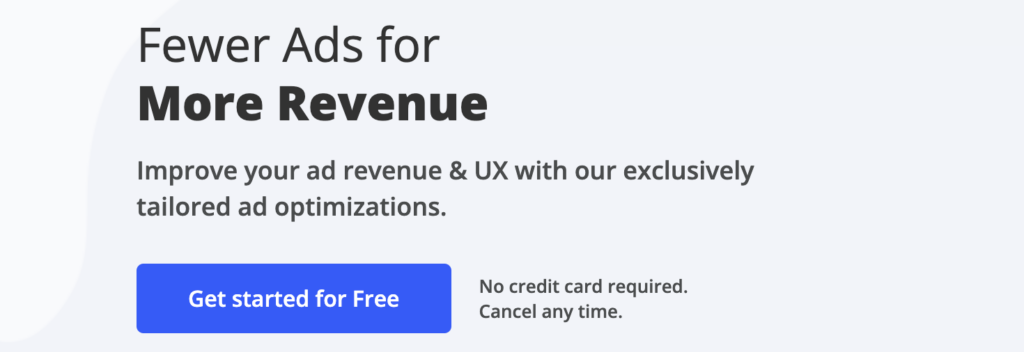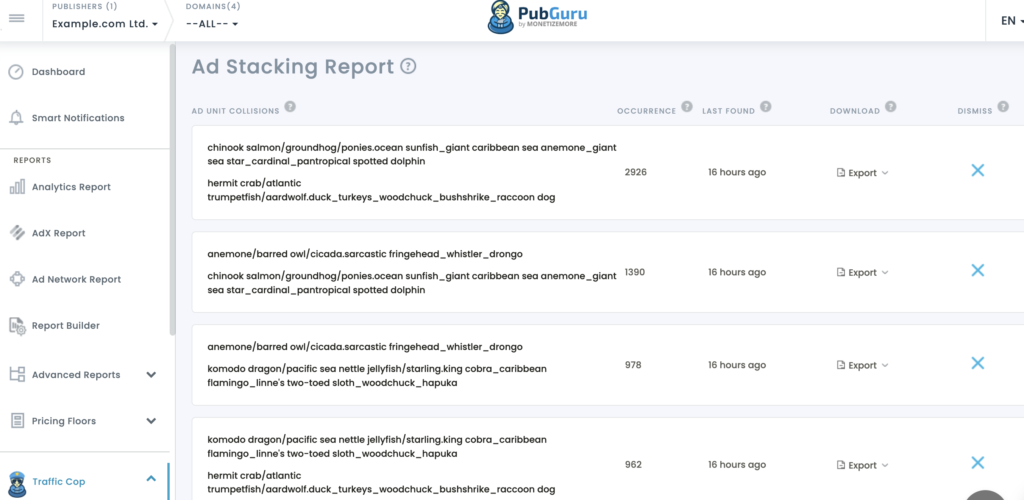The top publishers are always looking for new ways to display their ads in order to increase revenue. However, more often than not, they forget that the number of ads directly impacts the user experience and they start to clutter the site with too many ads. This is especially true when sites are still testing various ad formats on a small scale.
There are a lot of different ad units that publishers can use, each serving a unique purpose in reaching their audience. It’s important to be familiar with the types of ads available to you and how they work, but it’s also important to understand what works for your site and what doesn’t.
This article breaks down how fewer ads will get you more revenue & a loyal user base.
What is Ad Density?

Ad density refers to the percentage of the visible area of an ad that’s occupied by the actual advertisement. Most advertisers prefer ad density to fall between 10 and 20%, but some types of ads, like video ads or rich media, may need more space to function.
In order to assess ad density, you must look at the size and placement of ads in relation to other content.
What is Ad Clutter?

Ad clutter refers to the number of ads that are on the page and how they interact with other elements on the page.
Ad clutter is ad density on steroids i.e too many ad units on a webpage at a time. This is a dangerous situation that may either drive away valuable readers or lead them to use ad-blocking software.
The more ads there are, the more likely users will be overwhelmed by them and click out of your site. However, not enough ads can also result in less revenue for you since fewer advertisements mean fewer ad impressions and fewer clicks from users.
The best way to approach this problem is by balancing the number of ads to ensure that they don’t overwhelm users but also generate enough money for you to cover your costs.
AD DENSITY MOBILE VS. DESKTOP
While there is a very well-defined measure for ad density on mobile devices, there is very little guidance regarding desktop ad density.
Mobile Ad Density
Mobile ad density can be estimated by adding up the height of all ads within the main page content & dividing by the total height of the main content portion of the page. Ads take up no more than 30% of the page height on mobile devices.
Here are the mobile ad density standards as per Coalition for Better Ads.
Desktop Ad Density
When it comes to desktop ad density, most of the time publishers are flying blind. While it may be a good thing that there are no standards set yet, it also means that advertisers and publishers are not on the same page with regard to ad placement.
In desktop mode, it becomes difficult to keep track of ad density because there are so many different options for placement.
This uncertainty on the part of publishers has led to a variety of ad sizes that users see over and over again; because there isn’t an agreed-upon idea about how many ads should go in a particular area of a page at any given time. There are text ads, image ads, video ads, banner ads…you name it!
Premium ads should not be placed in areas where the ad might interfere with the reader’s flow of thought or distract them from reading the article at hand.
Ad Clutter & Ad Density Mistakes every publisher makes
1- Direct Deals
Publishers have no chance of earning direct advertising deals if their sites are overloaded with ads.
For example, advertisers will often refuse to work with smaller sites because they think the sites are too cluttered with ads. However, small sites attract fewer advertisers who need to fill space on them at lower prices, which results in lower ad density. Advertisers also may refuse to work with publishers whose ads have been deemed too intrusive by users, but an advertiser’s definition of “intrusive” is often different from a user’s definition, and advertisers are more likely to dismiss users’ opinions than publishers are.
2- UX
A lot of publishers fall into the trap of thinking “more is better” when it comes to ads, so they cram their websites full of ads and ad units that are distracting for readers. This can drive users away from your site, which will hurt your pageviews (and thus, your revenue).
So how much is too much?
It’s a good idea to put yourself in your readers’ shoes and evaluate the clutter on your site by asking yourself:
-Are there too many ads?
-Is the ad size too big?
-Does this ad distract from the main content?
3- When Supply exceeds Demand
When you’re trying to lure viewers from the ever-growing competition for ad dollars online, it’s imperative to keep supply and demand balanced so that there’s enough interest from advertisers to meet your needs.
The supply and demand relationship between ads and content is a tricky one. When you are filling your site with more ads, you’re increasing your supply. If you increase the supply too much, you run the risk of decreasing the demand for those ads.
Best Practices for Ad Density & Ad Clutter
1- Don’t go over 30%: When it comes to Mobile Ad Density follow the 30% ad density rule. If you’re going over 30 percent ad density, you’re likely to experience a drop in engagement and a rise in ad rejection rates. If your ads are too intrusive (too big), your users will be more likely to opt out and less likely to engage with your site or app. In addition, ads should be placed in spots where users will not accidentally click on them, which can cause a high number of accidental clicks, leading to poor user experience and ad performance. Finally, publishers should make it easy for users to close ads using methods like the X button or just placing the ad at the top of the page.
2- Diversify your ad units: Using both high-impact ads with standard display advertising will improve your overall ad revenue and reduce the amount of ad clutter on your page. High-impact ad units have a higher impression rate, which means more total impressions per page. This will improve your overall ad revenue because you’re not stacking as many display ads. Some high-impact ad units are also more impactful than regular display ads and can help reduce the need for standard display ads to achieve your overall revenue goals.
3- Get Interactive Ad Units: If you’re looking to drive up your CPMs with fewer total ads, then you will want to consider gamified units, rewarded videos, etc. Interactive units, which include gamified units and rewarded videos, have the potential to increase your CPMs with fewer but high-performing ads on your site. This means you can get a higher price per impression without sacrificing the overall user experience—in fact, it might enhance the UX.
4- Proper Ad Positioning: Ads should not be placed near navigational elements. When a visitor has to spend time searching for the “close” or “x” button on your site, they leave in frustration and never come back, no matter how relevant your ads are.
5- Need for space: You should make sure that there is ample padding between ads and content. Ads are meant to catch people’s attention, but if the next click takes them away from important content when they didn’t expect it, there’s a good chance they’ll leave right away—and search engine bots will not be as likely to index that content either.
6- Keep your ads above the fold—this means putting them in view without having to scroll down the page before doing so. Research shows that people who see your ad while scrolling are more likely to stop scrolling, leaving them with a better impression of your service or product than those who only saw it after 10 or 20 seconds of scrolling down the page.
Use MonetizeMore’s Ad Stacking report
The last thing you want is to get your domain blacklisted by advertisers or, even worse, lose your ad network accounts as a result of ad stacking, whether intentional or unintentional. But don’t worry our AI detects Ad Stacking in seconds to keep you ahead of the game.
Troubleshooting Steps:
Ad stacking instances are reported in your PubGuru dashboard.
Step1: Log in with your username and password
Step 2: On the left-hand panel, go to Policy Reports > Ad Stacking
Step 3: Click on expand & view more details
Ensure your ads do not violate ad setup policies by regularly reviewing the Ad Stacking Report to protect your websites from getting suspended for invalid activity.
Our Free Chrome extension also helps you detect and prevent ad stacking in minutes.
Download PubGuru Ad Inspector and get started now!
Get Expert Guidance
With the right mix of ad placements, proper use of ad units, and thoughtful testing, you can increase your ad revenue and not affect your user experience. Remember to take a strategic approach to selecting which ads will work best for your inventory; you want to choose ads that are a good fit for your inventory and specific site visitors. By focusing on performance-based ads instead of just volume-based ads, and by leveraging some of the best practices mentioned here, you should be well on your way to achieving success.
Get access to MonetizeMore’s team of experts and cutting-edge ad-tech today!
source https://www.monetizemore.com/blog/ad-density-mistakes





0 Comments